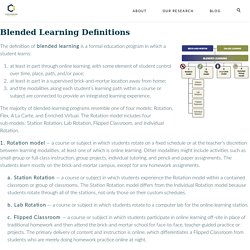

Different faces of blended learning. School administrators overwhelmed by the idea of blended learning need not fear: many districts have successfully implemented one of four models now widely accepted in K12 education.

Even more encouraging, some of these schools are seeing increased achievement, lower dropout rates, and other positive results. Blended learning involves a student learning partly through online instruction and partly with a teacher in a school building. Students may complete online instruction in a classroom, a computer lab, or at home, with varying degrees of control over time, place, path, and pace. The time with a teacher is often less structured than in traditional classes, with teachers providing small group or one-on-one support rather than lecturing to the entire class.
The Clayton Christensen Institute, formerly the Innosight Institute, is a nonprofit dedicated in part to researching and promoting blended learning. Blended learning is spreading quickly. Rotation model Flex model A la carte model. Blended Learning Definitions. The definition of blended learning is a formal education program in which a student learns: at least in part through online learning, with some element of student control over time, place, path, and/or pace;at least in part in a supervised brick-and-mortar location away from home;and the modalities along each student’s learning path within a course or subject are connected to provide an integrated learning experience.

The majority of blended-learning programs resemble one of four models: Rotation, Flex, A La Carte, and Enriched Virtual. The Rotation model includes four sub-models: Station Rotation, Lab Rotation, Flipped Classroom, and Individual Rotation. 1. Rotation model — a course or subject in which students rotate on a fixed schedule or at the teacher’s discretion between learning modalities, at least one of which is online learning. A. B. C. D. 2. 3. 4. Blended Learning Models. Blended Learning: Personalizing Education for Students - New Teacher Center, Silicon Schools Fund, Clayton Christensen Institute.
About this course: Plenty of buzz exists about blended learning and its transformational potential. But what does blended learning really mean? In this course we will explore the different models of blended learning and dive into key issues that impact students, teachers, and schools. Specifically, we will look at these issues through the lens of three high-performing schools that each use a different type of blended learning. The Ultimate Guide to Blended Learning Models. Have you heard of Blended Learning?

Youre probably rolling your eyes at the screen. If you've been anywhere in the remote vicinity of the education realm in the past couple years, you've heard of and have probably seen efforts to blend online and offline learning in your classrooms and schools. On a very basic level, Blended Learning is simply the use of online learning (via the web, digital program, or other digital means) and offline learning (traditional brick-and-mortar setting, group-based projects, discussion, etc.) as a means to personalize instruction within the classroom.
However, as the Clayton Christensen Institute for Disruptive Learning noted, even the definitions of "Blended Learning" are not a one-size-fits-all construct. Blended Learning Models Defined Below are four major Blended Learning models, each providing students and educators flexibility and learning environment variety (as defined by the Clayton Christensen Institute): 1) The Rotation model: 2) The Flex model. Blended Learning: 4 Blended Learning Models.